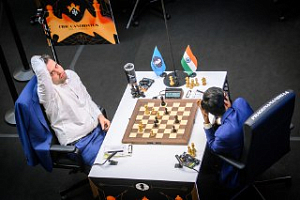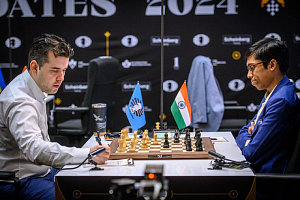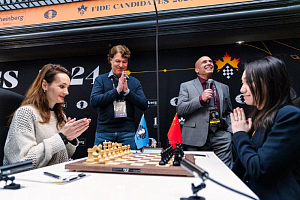11 August 2015
A Bus Driver and the Zero-Tolerance Rule
Round One of the Superfinal in the review of Vladimir Barsky and Eteri Kublashvili.
Although the city of Chita has embraced the chess players with the 30-degree heat, the dry air makes it quite tolerable. Also, there are people who like it hot! The summer is said to be over at the Baikal on August 22, so the timing for the Superfinal has been chosen with a great deal of precision.
As we have already mentioned before, the natives of Chita have done a titanic job of making everything prepared for the Superfinal and have literally welcomed the players and organizers with their arms open. As for the city itself, it is cozy and rather small, so that it takes no more than half an hour to get around the whole of its center. Getting lost in the capital of the Zabaykalsky Krai is difficult: the streets are parallel and perpendicular to each other. The decembrists D. Zavalishin and P. Falenberg, who were exiled to Chita shortly after the uprising of 1825, took the St. Petersburg’s layout as a basis and went on using it to plan out the prison building of Chita (which received the town status only in 1851). Wooden structures in the center of the city have survived until this very day, not to mention the numerous buildings of the Soviet period.
There is no end of flowers around you, which certainly transforms the urban landscape into quite a pleasure to rest your eyes upon. However, the symbol of the region and the lucky talisman of the Superfinal – the wild rosemary in all its glory – has remained unseen, and, alas, will not be seen any soon since its blossom falls in the beginning of June.
The participants are shuttled by bus all the way from the hotel to the tournament venue, which is located in the Palace of Youth "Megapolis-Sport”. You could cover this much distance in about half an hour, but the excessive heat has kept any potential volunteers out of it. On the day of the first round the bus nearly left Denis Khismatullin and his second Dmitry Bocharov behind when, almost immediately after starting off, it turned out that the rule of zero tolerance had been violated not by the grandmasters, but rather by the driver who hit the road at 14:28, two minutes ahead of the scheduled time. The bus returned, picked up the grandmasters and resumed its way. Meanwhile, it should be noted that the participants are not allowed to be late for the game by more than 15 minutes. In truth, any player to be late will have to deal with a fine of 10 thousand rubles in favor of the Russian Chess Federation: the money will be used to reimburse the costs of the event, as so specified in the tournament Regulations.
The "Megapolis-Sport" provides a spacious, well-lit hall for the games, while next to it is a recreation room where you can have your tea or coffee, as well as a snack. The outdoor heat is not felt inside, since the air conditioning is operating at full might. Perhaps it should even be brought down to a degree, as certain participants even started to feel somewhat chilly. Here and there the video cameras are installed; a feature that has become such an indispensable sign of the major chess events that no one seems to pay any attention anymore. There is also room for the audience; it is of a rather moderate size, but is located right in front of the tables where the girls play. Men occupy the recess of the playing hall, while the referees' table is still a little further; there is also a separate room allocated for the referees. In general, there is more than enough space for everyone to walk, do his work and relax.
The Zabaykalsky Krai Governor Konstantin Ilkovsky made the symbolic first move in the game of the most famous participant – the 12th World Champion Alexandra Kosteniuk – by helping her move the pawn from d2 to d4. In response Anastasia Bodnaruk developed the knight on f6, at which moment the first "self-played" move by Alexandra came as a surprise: 2.Nc3!? – the Veresov opening! After a short and not particularly eventful middlegame the game petered out into slightly better endgame for White; however, the Russian online commentators Mark Glukhovsky and Sergei Shipov believed that Black should retain a draw without any particular problems. In the final run this predicted result turned out to be true, on the way to which, however, Black messed up and found himself facing serious difficulties; but then it was the former World Champion’s turn to commit a mistake, letting all her advantage disappear.
At the same time the tournament coverage in the English language has been organized as well, with grandmasters Evgenij Miroshnichenko and Anna Burtasova commenting on the course of the events for us. While they are hosted somewhere in the depths of the "Megapolis", Shipov and Glukhovsky are used to be visited not only by the spectators and listeners, but also by storytellers out of the most distinguished grandmasters of the day. Ivan Bukavshin and Igor Lysyj, who generated one of the most head-spinning and spectacular games, turned out to be the first guests of the studio: after White sacrificed two pieces, the black king, being under severe fire, had to escape through d5 to c6, with mating threats hanging strongly in the air...As was admitted by the Russian Champion, some of the White’s moves came as entirely unexpected for him and he was more than once on the verge of being convinced that he was about to lose, when he nevertheless succeeded in coming up with the only defensive resource available to him in the position. I wonder at which moment the opponents found themselves out of their books: the engine’s evaluation never deviated from the equality until the very end of the game.
Round one would see no more such spectacular and genuine games. While Evgeny Tomashevsky was attempting to retain the gambit pawn in one of the offshoots of the Catalan Opening, his opponent, Dmitry Jakovenko, was resourcefully maintaining the initiative, which provided him sufficient compensation for the minor “lack” in material. Playing Black was easier, and shortly prior to the time control Evgeny committed an oversight.
Tomashevsky – Jakovenko

White should have advanced his pawn from being en prise with 35.c5, after which Black has a choice between the calm move 35...h6, and the more aggressive 35...h5. Instead of this Tomashevsky defended the pawn with 35.Rc2?, missing the 35...Rd3! stab that would have brought him face-to-face against heavy consequences: after 36.Qb5 Nxf3+ 37.Rxf3 Qxb5 38.cxb5 Rxf3 Black has excellent chances to convert his exchange sacrifice advantage.
However, Jakovenko failed to seize the opportunity that came his way, and after 35...Qa4 36.Rc3 Nxf3+ 37.Rxf3 Rxe1+ 38.Kg2 R1e2+ 39.Kh3 R2e6 40.Rf2 Qc6 41.Qxc6 Rxc6 the game ended in a draw.
Daniil Dubov played out the Volga Gambit quite unsuccessfully against Ildar Khairullin, when at the end of the opening part of the game Black found himself down a pawn, with no any special compensation for it. In a slight time trouble Ildar missed the opportunity to effectively finish the game.
Khairullin - Dubov

The grandmaster from St. Petersburg was very likely to have seen the rejoinder 30.Nxe7! (with the idea of meeting 30... Kxe7 with 31.Nc6+ and 32.Qxf6), but could have been confused by the riposte 30...Na4!? In this case, however, White wins in a rather spectacular manner after the second knight’s plunge onto the adjacent square: 31.Ne6+!! fxe6 (or 31... Kxe7 32.Qc7+ Nd7 33.Qd8#) 32.Qxf6 + Ke8 33.Qxe6, and the white king finds shelter from further checks on h3.
It should be noted, however, that even after the continuation that occurred in the game (30.Qc2) Khairullin could have still brought his advantage home, but failed to profit from a number of his "scoring chances", while Dubov managed to salvage half a point through the tenacious defensive play.
The Russian Chess Federation website will publish grandmasters’ reviews of the most interesting snippets of the fight, so let's not start galloping ahead of the due course of events. However, there is one game episode that I would like to draw attention to.
Gunina– Goryachkina

Valentina managed to have her younger opponent confused in the midst of maneuvering struggle as Sasha had just inadvertently left her d8-rook unprotected, after which White featured the combinational motif by delivering a fork to e4 and d8. Gunina recognized the winning idea, but used the wrong sequence of moves to make of its use.
28.Bxe4? Bxe4 29.Qh4? (better was 29.fxg7, although after 29...Be7 Black is not worse, as a minimum) 29...Bc2, and it was probably only at this moment that Gunina realized that 30.fxg7 is followed by 30...Be7, leaving White down some material. However, after 30.Rd2 Bxb3 White did not manage to last long either.
Meanwhile, in the position on the diagram White should have started with 28.fxg7!
1) Now the straightforward 28...Bxg7 runs into 29.Bxe4! Bxe4 30.Qh4 – forking two pieces, whereas 30...Qg6 is impossible because the d8-rook is captured with a check.
2) 28...Be7 runs into a nice riposte after 29.Nc3 Nxc3 30.Bf5! Qf6 31.Bh7+ Kxh7 32.Rxf6.
3) The most stubborn continuation is 28...Kxg7, although after 29.Nc3 (now 29.Bxe4 Bxe4 30.Qh4 yields nothing in view of 30...Qg6 with a mating threat on g2, and White is not in time to grab the rook) 29...Nf6 (29...Nxc3 30.Bxc3 looks rather grim) 30.Qh4 with a large positional edge.
Well, it should be recalled that a year ago Valentina Gunina started off in the Superfinal in exactly the same way by losing to Aleksandra Goryachkina in round one. A lot more important question is whether she will be able to finish off the race along the lines that happened in Kazan then?
The women's section features two more games ended with wins as Olga Girya skillfully outplayed Evgenija Ovod in the ending, while Natalija Pogonina broke down the resistance of Alina Kashlinskaya, who was striving for victory somewhat too eagerly. In the men’s section it was Sergey Karjakin who became the hero of the day, having overcome the stubborn resistance of Denis Khismatullin following six hours of the game. Karjakin’s replies at the press conference were really impressive as he rose to the occasion of perfectly well detecting the numerous minor tactical tricks, while quickly and accurately finding rejoinders to the moves that were proposed by Sergei Shipov. It is clear that the recent "China trip" helped Karjakin in getting into a good shape, having raised his high spirit while adding confidence in his own capabilities.





















